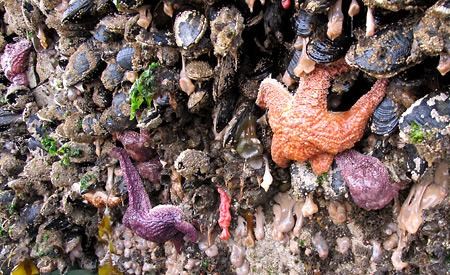Sea stars are wasting away and marine biologists do not know why. Powell River residents are asked to help by reporting sightings of sea stars affected by Sea Star Wasting Syndrome.
This group of invertebrates, which lights up the marine scene with vibrant colours of deep purple, orange and leathery brown, is facing some kind of disease which is literally melting the animals from the inside out.
Sea Star Wasting Syndrome has been identified from Mexico right up the Pacific West Coast to Alaska. Confirmed occurrences closest to Powell River are off the east coast of Vancouver Island at Port Hardy, Port McNeill and Nanaimo, and south in Howe Sound.
“About 10 species of starfish are affected,” said Sabina Leader Mense, biologist located on Cortes Island, who was speaking with Malaspina Naturalists Club recently on the subject of intertidal wilderness. She said three species, the common purple (Pisaster ochraceus), the leather star (Dermasterias imbricata) and the sunflower star (Pycnopodia helianthoides) are the hardest hit.
The syndrome appears first as white lesions on the surface of the sea stars. Within a couple of days the lesions have spread over the entire animal. The next symptom is an inability for the sea stars to attach and hold onto rocks. A sea star has a vascular system which pumps sea water through its body and forces the water into the fingers in the feet. This allows it to hold on. It can release the flow in order to detach and move. The wasting syndrome removes this ability.
“They no longer have the use of their tube feet, they get flattened, they have no turgidity, they fall off and literally start falling apart within a few days,” said Leader Mense. “Arms break off and you get this pile of decomposing rotting starfish.” The syndrome has not been seen in sea cucumbers, sea urchins or other species in the phylum, she reported.
Scientists are trying to determine the cause of the syndrome. A similar syndrome was noted in 1970s and 1980s, but the current outbreak has a far larger geographical distribution. Under consideration are warmer ocean temperatures related to the El Niño effect, changes in salinity or ocean acidification. “What people are clear on is there is definitely something stressing starfish.”
Leader Mense’s concern is echoed by Jackie Hildering, biologist, teacher, scuba diver and author of www.themarinedetective.com blog. Her website carries photographs of sea stars affected by the syndrome.
“I am hoping that kayakers, beach-walkers and fellow divers will help monitor and report on the spread of this disease,” she wrote.
Anyone noticing the affects of the syndrome on sea stars is asked to contact Vancouver Aquarium through its website.
“Sea Star Wasting Syndrome reminds us of the fragility of ocean ecosystems and how very quickly disease could spread in the ocean,” wrote Hildering.



